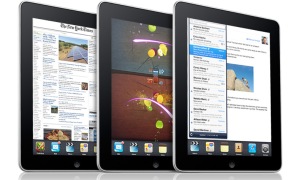Despite a rough first quarter on the stock market and fierce competition growing in the smartphone and tablet market, there is still no sign of Apple Inc. slowing down. With Apple mobile devices soon becoming available in Turkey, sales figures rising significantly in China, and a continuing pattern of acquisition and adoption in the fields of new, innovative core technology, Apple will face tough competition in years to come, but will ultimately remain the unrivaled leader in innovation and quality as the decade unfolds.
A Track Record for the Future
Perhaps the best way to see into the future of Apple is to take a quick look at their past. With a history of buying off and buying out smaller, specialized companies, the expansion and development of Apple’s product line will likely follow the company’s acquisition trends.
From the very beginning of the Macintosh project in 1979, when Steve Jobs and several Apple engineers visited Xerox’s development center in Palo Alto, methods of borrowing and buying-out were already beginning to emerge. In exchange for some Apple stock options, Jobs and the engineers were allowed access to the Xerox Alto machine, which featured a state-of-the-art graphic user interface that would later come to full fruition in the first Mac OS in 1984.
Further down the line, following the purchase of Macromedia’s Final Cut software in 1998, Apple released the widely popular Final Cut Pro and iMovie. In 2002, Apple purchased Nothing Real and EMagic, which lead to their development of the digital compositing software Shake and the music production software GarageBand respectively. In 2001, after buying the rights to the new 1.8” Toshiba hard drive, contracting Portal Player to develop a media-player platform, and recruiting Pixo to design a new user-interface, Apple released the now famous iPod to worldwide success.
Signposts Ahead
With recent acquisitions of the 3D mapping company C3 Technologies, flash memory innovators Anobit, facial recognition software firm Polar Rose, HDR photography software developers IMSense, and the fingerprint security firm AuthenTec, Apple is only increasing its advantage over competitors who will still have to outsource to remain competitive in these fields. Looking at this laundry list of companies, you begin to see how Apple’s future product line will be bolstered with increased security and quality in a range of fields. Overall, retaining in-house manufacturing control over these sectors gives Apple a long-term advantage in key emerging technologies over the next decade.
The Global Marketplace and Beyond
Although China is currently Apple’s second biggest market, that may soon change. As recent sales figures indicate a 67 percent growth from the previous year and with new stores opening across the Chinese mainland, there is a good sign that Apple Inc. will become more of a global force in the next ten years. Furthermore, it appears Apple is opening its doors to Turkey and Brazil in the very near future. With recent job postings listed for retail stores in Istanbul and Rio de Janeiro, we may be witnessing the beginning of something much more widespread than the myopic marketplace of the USA and Europe.
Although there are several other companies such as Samsung, Nokia, and Google developing smartphone and tablet technology, it is unlikely they will be able to compete at the same level of quality as Apple. Overall, the sheer breadth and diversity of Apple’s product line coupled with their consistent business philosophy of acquisition and assimilation should make stockholders breathe easier in the coming years.


